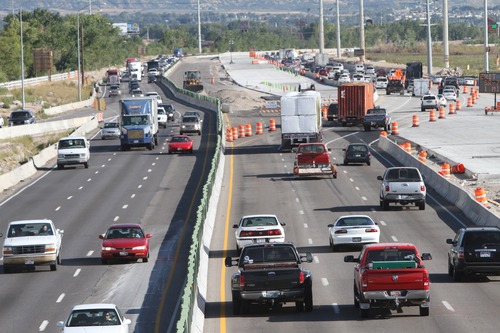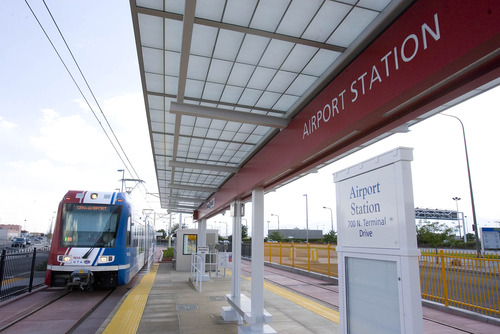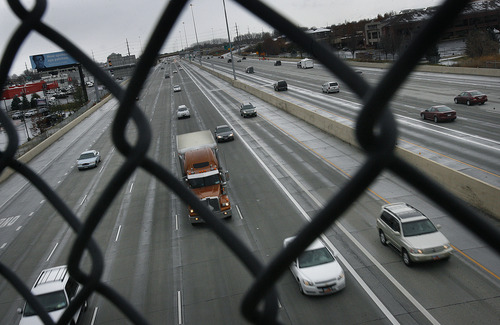This is an archived article that was published on sltrib.com in 2013, and information in the article may be outdated. It is provided only for personal research purposes and may not be reprinted.
Utah is about to face a tricky balancing act: how to raise taxes enough to fund new transportation projects that officials say are needed to fuel economic growth, but not make them so high that they chase away business.
The Legislature's Economic Development Task Force discussed Thursday how to find what Senate Chairman Stuart Reid, R-Ogden, calls "the sweet spot" as it heard reports on transportation needs over the next 30 years.
"As transportation opportunities improve, the economy grows," studies show, said Senate Majority Leader Ralph Okerlund, R-Monroe. But "if you raise the gas tax that would allow you to do more work and have better roads, that shows a negative effect on the economy. ... When you think about the 'sweet spot' idea and correlating the two, that's a challenge."
Rep. Brad Last, R-Hurricane, said it is even more complicated because transportation competes with other economic development needs for taxes, such as proposed projects to improve water supplies with a pipeline from Lake Powell or dams to capture more water from the Bear River. He said without them, it "will bring our economic possibilities in the state to a screeching halt."
Utah's 24.5 cents-a-gallon tax on gasoline and diesel fuel has not been raised in 16 years. Mayors and state transportation officials say an increase is needed soon to keep up with needed road maintenance — and mayors want an increase of at least 5 cents a gallon. Without such increases, a Utah Foundation report said the state would face a shortfall of $11.3 billion for high-priority transportation projects by 2040.
Meanwhile, the Utah Transit Authority has said that mass transit improvements outlined in the state's transportation plan for the next 30 years — from more streetcar, light rail and bus rapid transit lines to more frequent service that reaches more places — would require increasing sales taxes for transit along the Wasatch Front from a current average of 0.6 cent per $1 purchase to a full penny, a 67 percent jump.
Carlos Braceras, executive director of the Utah Department of Transportation, outlined Thursday some of the challenges on highway funding.
He said to maintain the quality of the state's freeways and other most-traveled highways, UDOT decided in recent years to halt regular maintenance on its less-traveled routes. He said that could be an expensive decision in the long run, because maintaining roads is up to 25 times cheaper than eventually being forced to rebuild them.
Also, he said about 700 bridges built in the 1960s and 1970s are nearing the end of their life span. While Utah has been replacing about 15 bridges a year recently, "we will have to step that up to 50 a year" soon.
Braceras said the state would need about $21 million a year to provide maintenance on its less-traveled highways, plus another $9 million a year for bridge replacement.
Steve Allred, with the legislative fiscal analyst office, said Utah now ranks ninth among all states in highway spending per capita, while its fuel tax is about average.
Matt Sibul, UTA chief planning officer, said the extra mass transit service and lines envisioned in state 30-year transportation plans would help attract new business and help better deal with population growth by reducing highway congestion and pollution.
Some $7 billion in investment has occurred on or near new mass transit projects in the past 14 years since TRAX was first added, he said. For example, along just the new Sugar House Streetcar line — which is scheduled to open in December — he said Salt Lake City reports $400 million in new private investment has begun to take advantage of it, and South Salt Lake reports about the same.
"You can see that transit and development, or redevelopment, go hand in hand," he said.
While projects included in current 30-year plans would require a sales tax increase to complete, Sibul said, "I'm certainly not here to ask for a tax hike, that's not the focus of this presentation," he said. But he said UTA wants lawmakers to "know the kinds of things we could deliver in the next decade" with one.
Not all big envisioned transportation improvements will require tax hikes. Maureen Riley, executive director of the Salt Lake City International Airport, outlined a $1.8 billion expansion it envisions over the next decade. She said it will be entirely funded by user fees from airlines and passengers, plus some possible federal grants.







